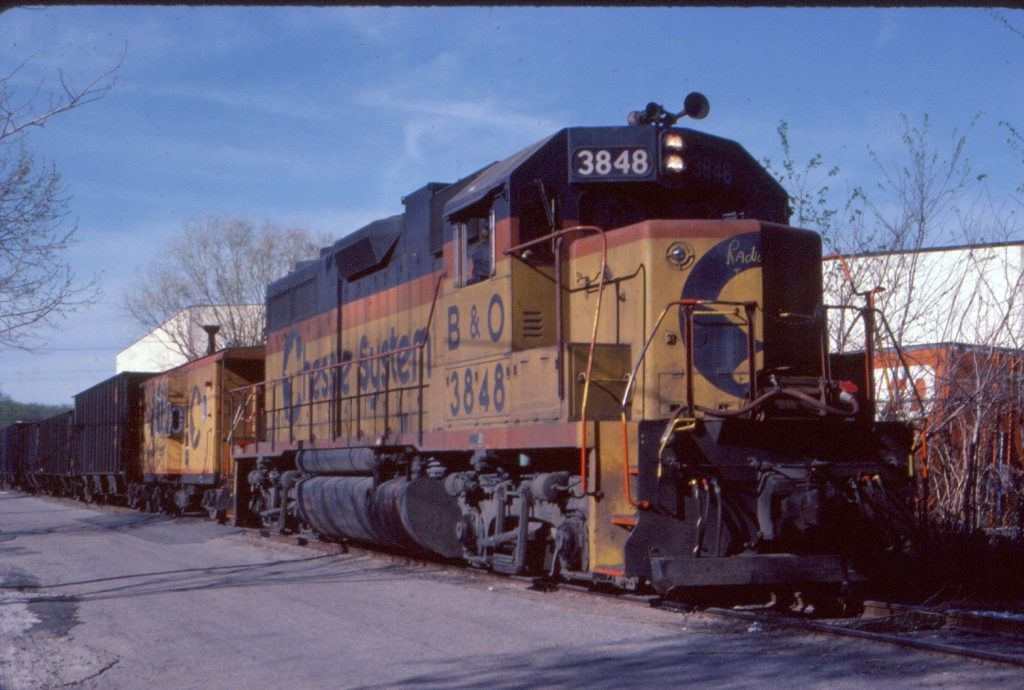
April 23, 1982. The Georgetown Local is heading down the Branch toward Georgetown and has just crossed River Road in Bethesda. B&O EMD GP38 3848 (blt 1967) is on point. From an eBay auction I recently won, photographer unknown. Note the graffiti on the nose which I assume reads “RADIO EQUIPPED.”
Cool find! If I’m not mistaken, was there at one point a siding to the left of the track that had perhaps been shortened by then? Wish some more pics of the actual crossing would pop up too at some point!
Hayden – sort of. There were three sidings in the general vicinity of the loco. One, behind and on the right side of the track. This led to the fuel dealer siding which is where the storage facility is in the background of the photo. Another siding was for the Betco Block factory, on the other side of the tracks but further to the right (in front) of the loco. The one you may be thinking of was to the left of the loco, but behind the photographer. It branched off just behind the photographer, and rose up above the main line just a few feet. There, there was a tank car unloading facility where oil was unloaded via hoses and pipes down, under the tracks and to storage tanks in the area below where there was another fuel distributor. I visited this location a few months ago and found the tracks are still in place as are the old unloading apparatus. (valves, pipes, hoses) You can see photos in the gallery. Cool stuff! Here is the page where I wrote about it: http://gbblog.sluggyjunx.com/2019/01/24/georgetown-branch-odyssey
Yeah the last one you mentioned probably is it what I was picturing, crazy how the tracks remained hidden there for so long! Never knew about the siding leading to Betco either, this particular section of the line must’ve been hell for track crews to maintain since I read (prob on your site) somewhere that apparently in later years the lengths of the sidings were altered frequently and connected and disconnected to the main on a regular basis.
Here are some photos of the area where you can see the old Betco Block siding. http://gallery.sluggyjunx.com/railroad_and_industrial/georgetownbranch/gb_prototype_photos/20030118-gb_tour That day, we missed out on finding the old oil siding only b/c we didn’t walk down that far. It was right behind us in the group photo! One more, here is a shot from May 30, 1956 showing the Betco plant receiving a few carloads of cinders. Gives you an idea of the curvature. http://gallery.sluggyjunx.com/railroad_and_industrial/georgetownbranch/gb_prototype_photos/r_mumford_collection/mumford-b-w_prints/37
I’m not sure about sidings being shortened often in later years. They certainly shortened/removed some as service waned and development took over the area.
That’s a groovy pic from ’56, is the caboose on the main?
Yes it is.
Nice shot! I worked at the Security Storage warehouse in the background of the photo in the summer of 1980. I saw the Georgetown Local many times that summer and growing up in Palisades DC.
Matthew – that’s awesome! I love to hear stories from folks who experienced the trains. Do you recall what time of day and what days of the week the local ran back then? Also, about how frequently? I wish I could have been there. 🙂 Thank you!
In regards to shortening/removing the siding.
The siding to the west across the tracks from Betco block formerly used for oil unloading was largely overgrown by 1980, however a wooden B&O caboose was located on it, but abandoned by this time. When welded rail was installed in 1980, this siding was not connected. However in 1982 (I think) the siding was reconnected by a B&O track crew and Jack’s Roofing (located nearby in a building not quite on the siding, but south of River Road) began receiving boxcars of cedar shingles every two weeks. These deliveries had stopped before 1985.
I remember one day the Georgetown switcher arrived from Eckington with one car to deliver to Jack’s Roofing. It was the summer and no coal was moving and by this time Gallagher Lumber in Georgetown was gone. Jack’s and TW Perry in Chevy Chase were the only customers left besides GSA. The train throttled up, the conductor threw the switch while a brakeman pulled the pin and the locomotive ran up onto the siding while the train drifted past on the mainline with a brakeman on board the caboose controlling the speed via handbrake. the locomotive backed out and reconnected and spotted the boxcar and departed.
Thank you for the details, Christopher! Very useful info. Do you know who the caboose belonged to? Have always wondered.